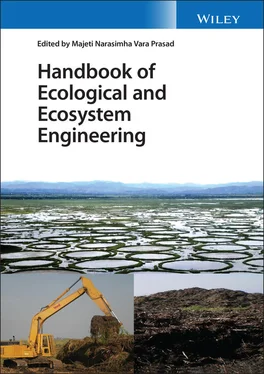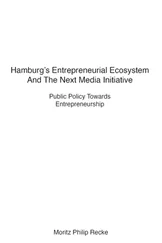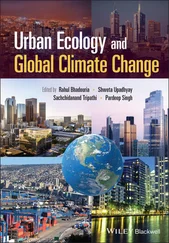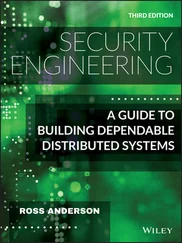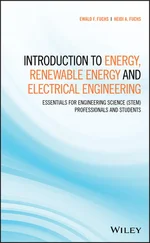18 18 Gattie, D.K. and Foutz, T.L. (2007). Systems and engineering ecology: developing formal foundations for ecological engineering. Int. J. Eng. Educ. 23 (4): 683–690.
19 19 Gattie, D.K., Kellam, N.N., and Turk, H.J. (2007). Informing ecological engineering through ecological network analysis, ecological modelling, and concepts of systems and engineering ecology. Ecol. Model. 208: 25–40.
20 20 Goodsell, P.J., Chapman, M.G., and Underwood, A.J. (2007). Differences between biota in anthropogenically fragmented habitats and in naturally patchy habitats. Mar. Ecol. Prog. Ser. 351: 15–23.
21 22 Jansson, R., Backx, H., Boulton, A.J. et al. (2005). Stating mechanisms and refining criteria for ecologically successful river restoration: a comment on Palmer et al. (2005). J. Appl. Ecol. 42: 218–222.
22 23 Leń, P. and Noga, K. (2018). Prioritization of land consolidation interventions in the villages of Central Poland. J. Ecol. Eng. 19 (2): 246–254.
23 24 Lewis, R.R. III (2005). Ecological engineering for successful management and restoration of mangrove forests. Ecol. Eng. 24: 403–418.
24 25 Lutz, W. and Kc, S. (2010). Dimensions of global population projections: what do we know about future population trends and structures? Science 365: 2779–2791.
25 26 Ma, S. (1985). Ecological engineering:application of ecosystem principles. Environ. Conserv. 12: 331–335.
26 27 Ma, S. and Yan, J. (1989a). Ecological engineering for treatment and utilization of wastewater. New York: Wiley. pp. 185‐217.
27 28 Ma, S. and Yan, J. (1989b). Ecological Engineering: An Introduction to Technology [M] (eds. W.J. Mitsch and S.E. Jørgensen), 365–380. New York: Wiley.
28 29 Mace, G.M., Norris, K., and Fitter, A.H. (2012). Biodiversity and ecosystem services: a multilayered relationship. Trends Ecol. Evol. 27 (1): 19–26.
29 30 Malakoff, D. (2004). The river doctor. Science 305: 937–939.
30 31 Martin, J.F., Roy, E.D., Diemont, S.A.W., and Ferguson, B.G. (2010). Traditional Ecological Knowledge (TEK): ideas, inspiration, and designs for ecological engineering. Ecol. Eng. 36: 839–849.
31 32 Mitsch, W.J. (2010). The 2010 Gulf of Mexico oil spill: what would Mother Nature do? Ecol. Eng. 36: 1607–1610.
32 33 Mitsch, W.J. and Jørgensen, S.E. (eds.) (1989). Ecological Engineering: An Introduction to Ecotechnology. New York: Wiley.
33 34 Mitsch, W.J. and Jørgensen, S.E. (2003). Ecological engineering: afield whose time has come. Ecol. Eng. 20: 363–377.
34 35 Mitsch, W.J. and Jørgensen, S.E. (2004). Ecological Engineering and Ecosystem Resturation. New York: Wiley.
35 36 Mitsch, W.J., Day, J.W. Jr., Wendell Gilliam, J. et al. (2001). Reducing nitrogen loading to the Gulf of Mexico from the Mississippi River Basin: strategies to counter a persistent ecological problem. BioScience 51: 373–388.
36 37 Odum, H.T. (1962). Ecological tools and their use: man and the ecosystem. Lockwood Conference on the Suburban Forest and Ecology.
37 38 Odum, H.T. (1971). Environment, Power and Society. New York: Wiley.
38 39 Odum, H.T. (1983). System Ecology. New York: Wiley.
39 40 Odum, H.T. and Odum, B. (2003). Concepts and methods of ecological engineering. Ecol. Eng. 20: 339–361.
40 41 Palmer, M.A., Hart, D.D., Allan, J.D., and the National River Restoration Science Synthesis Working Group (2003). Bridging engineering, ecological, and geomorphic science to enhance riverine restoration: local and national efforts. In: Proceedings of the National Symposium on Urban and Rural Stream Protection and Restoration (eds. P. Bizier and P. DeBarry). Philadelphia: EWRI World Water and Environmental Congress. Reston, VA: American Society of Civil Engineers.
41 42 Palmer, M.A., Bernhardt, E.S., Allan, J.D. et al. (2005). Standards for ecologically successful river restoration. J. Appl. Ecol. 42: 208–217.
42 43 Pašakarnis, G. and Maliene, V. (2010). Towards sustainable development in central and Eastern Europe: applying land consolidation. Land Use Policy 27 (2): 545–549.
43 44 Pedersen, M.L., Andersen, J.M., Nielsen, K., and Linnemann, M. (2007). Restoration of the Skjern River and its valley: project description and general ecological changes in the project area. Ecol. Eng. 30: 131–144.
44 45 Peterson, S.B., Teal, J.M., and Mitsch, W.J. (eds.) (2005). Delaware Bay salt marsh restoration. Ecol. Eng. 25 (special issue): 199–314.
45 46 Qin, L.L., Li, K.F., Li, Y. et al. (2016). A habitat similarity model based on vague sets to assess Schizothorax prenanti spawning habitat. Ecol. Eng. 96: 86–93. https://doi.org/10.1016/j.ecoleng.2016.04.007.
46 47 Seitz, R.D. and Lawless, A.S. (2006). Landscape‐level impacts of shoreline development on Chesapeake Bay benthos and their predators. In: Management, Policy, Science, and Engineering of Nonstructural Erosion Control in the Chesapeake Bay (eds. S.Y. Erdle, J.L.D. Davis and K.G. Sellner), 63–70. Chesapeake Bay: CRC Publ. No. 08‐164.
47 48 Society for Ecological Restoration (SER).(2002). The SER Primer on Ecological Restoration. SER International Science and Policy Working Group. www.ser.org/content/ecological restorationprimer.asp.
48 49 Sree Latha, E. and Jesu Rajan, S. (2018). Ecological engineering for sustainable agriculture: simple concept with greater impact. Int. J. Sci. Res. Publ. 8 (2): 123–125.
49 50 Straškraba, M. (1993). Ecotechnology as a new means for environmental management. Ecol. Eng. 2: 311–332.
50 51 Tang, D., Zou, X., Liu, X. et al. (2015). Integrated ecosystem health assessment based on eco‐exergy theory: a case study of the Jiangsu coastal area. Ecol. Indic. 48: 107–119.
51 52 Tang, D., Liu, X., and Zou, X. (2018). An improved method for integrated ecosystem health assessments based on the structure and function of coastal ecosystems: a case study of the Jiangsu coastal area, China. Ecol. Indic. 84: 82–95.
52 53 Teal, J.M. (1991). Contributions of marshes and saltmarshes to ecological engineering. In: Ecological Engineering for Wastewater Treatment (eds. C. Etnier and B. Guterstam), 55–62. Gothenburg, Sweden: Bokskogen.
53 54 Teal, J.M. and Weinstein, M.P. (2002). Ecological engineering, design, and construction considerations for marsh restorations in Delaware Bay, USA. Ecol. Eng. 18: 607–618.
54 55 Thom, R.M. (2000). Adaptive management of coastal ecosystem restoration projects. Ecol. Eng. 15: 365–372.
55 56 Turner, R.K., van den Bergh, J.C.J.M., Soderquist, T. et al. (2000). Ecological–economic analysis of wetlands: scientific integration for management and policy. Ecol. Econ. 35 (1): 7–23.
56 57 Uehara, T. and Mineo, K. (2017). Regional sustainability assessment framework for integrated coastal zone management: satoumi, ecosystem services approach, and inclusive wealth. Ecol. Indic. 73: 716–725.
57 58 Ulanowicz, R.E. (1990). Aristotelian causalities in ecosystem development. Oikos 57: 42–48.
58 59 Ulanowicz, R.E. (1999). Life after Newton: an ecological metaphysic. Biosystems 50: 127–142.
59 60 Van der Ryn, S. and Cowan, S. (1996). Ecological Design. Washington, DC: Island Press.
60 61 Wolters, M., Bakker, J.P., Bertness, M.D. et al. (2005). Saltmarsh erosion and restoration in south‐east England: squeezing the evidence requires realignment. J. Appl. Ecol. 42: 844–851.
61 62 World Commission on Environment and Development (1987). Our Common Future, 98. Oxford, UK: Oxford University Press.
62 63 Xiao, Y. and Xiao, Q. (2018). Identifying key areas of ecosystem services potential to improve ecological management in Chongqing City, southwest China. Environ. Monit. Assess. 190: 258.
63 64 Johnson, M.F., Thorne, C.R., Castro, J.M. et al. (2020). Biomic river restoration: A new focus for river management. River Res. App. 36 (1): 3–12.
Читать дальше
